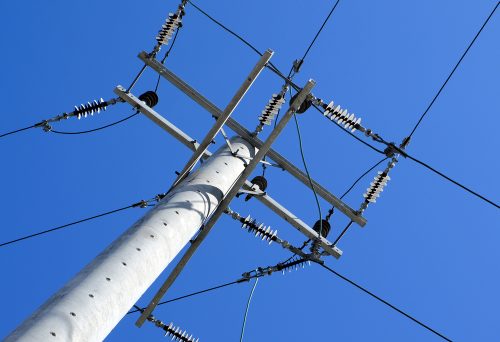Private power lines help level the playing field for businesses far from the power grid. A private electricity infrastructure lets you escape the sky-high energy costs associated with diesel-powered generators. It grants you access to affordable and reliable power sources, lowering your production costs.
But before you can pass these cost-saving benefits to your customers, your electricity grid must adhere to the set electrical regulations. In particular, you should pay attention to the minimum height of power lines in Australia. Beyond enhancing public safety, these regulations determine the stability and resilience of your private power grid.
At G&S Industries, we help businesses build the best-in-class private overhead power lines. Our custom-manufactured power connection poles meet the Australian Design Standards to ensure a seamless installation process. Here’s what you need to know about Australia’s minimum height of power lines.
Standard Power Pole Height in Australia
Australian power companies use a voltage-based system to determine the height of an electricity grid. Simply put, the amount of power passing through the power lines determines the height of the poles. For low-voltage lines—below 1 kV—the poles are at least 4.5 metres. For high-voltage lines—above 10 kV—the minimum height is 10 metres. Here’s a breakdown of the minimum height of power lines in Australia:
- 415V power lines: 4.5 to 6 metres
- 11kV power lines: 8 to 9 metres
- 19kV power lines: 11 to 13 metres
- 33kV power lines: 10 to 20 metres
Power poles are usually buried 2 to 3 metres in the ground to avoid toppling and unnecessary power interruptions. Burying a substantial length of a power pole is crucial for grid stability. It helps your infrastructure withstand anything Mother Nature throws at it—from gales to hurricanes and storms. The depth of the mounting hole varies across regions depending on the type of power line, the soil conditions, and wind loads.
A sturdy power pole installation also reduces the impact of car crashes on your grid. If a wayward car crashes into a pole at high speed, the rest of the grid won’t collapse like a pile of dominoes.
Naturally, the below-the-ground height adds to the overall length of the power poles. Therefore, the typical electrical pole height in Australia ranges from 6.5 metres for low-voltage power lines to 12 metres for high-voltage lines.
Why Are There Minimum Heights of Power Poles?
Power pole regulations and guidelines seek to maximise public safety while minimising power interruptions. When your grid meets the minimum pole height standards, the risk of accidental contact with high-voltage lines is slim to none. The vertical clearance can accommodate all vehicles, saving you from legal troubles.
Moreover, the power poles must be high enough to accommodate main cables and transformers. Since these attachments can potentially weigh down the grid structure, they must be mounted above a certain height.
A safe clearance height protects your power infrastructure while ensuring an uninterrupted power supply. Taller power lines tower above the tree lines and buildings, minimising accidental contact with branches even during the strongest gales or rain storms. That means no frantic calls to the power company to repair your grid after every rainstorm.
Setting the minimum height of power lines in Australia also helps you accommodate the terrain. You can easily adjust the pole heights to account for the varying elevations.
Safety Considerations When Installing Power Poles in Australia
Public safety is a primary consideration when installing private power poles. Having your poles at the right height helps prevent accidental contact with live wires, which may prove fatal or cause untold damage. This protects people and property while safeguarding the grid’s integrity and functionality. Prioritise safety by:
- Engaging licensed professionals: Installing power poles is a highly technical project best left to licensed experts. Only hire a certified contractor with accredited Level 2 electricians to avoid breaking the law. Such experts ensure your grid meets the required safety standards.
- Checking the local regulations: The minimum power pole height guidelines vary between regions. For instance, power pole installations in rural areas may have different requirements than those in urban areas. Check the localised requirements to avoid running afoul of your local council.
- Accounting for no-dig zones: A no-dig zone is a restricted area usually established around a power grid. Since building and construction activities in this area are strictly prohibited, a no-dig zone impacts property usage. You’ll need a special permit to undertake such activities. An expert can help you comply with the power line safe distance while minimising property usage restrictions.
- Choosing the best materials: The selection of power poles often comes down to steel, wood, titan, and composite materials. Each option has different strengths, costs, lifespan, and performance. A certified electrician will help you choose the best material for your budget and needs.
Risks of Non-Compliance with Minimum Power Pole Height Standards
Non-compliance with height standards carries dire legal and financial consequences, including:
- Public safety hazards: Low-hanging power lines due to improper pole height increase the risk of electrocution. The cables may also sag and harm people and animals passing below them.
- Huge losses: Low-hanging power lines may lead to frequent outages, which may lower your production capacity. Repairing downed power lines, poles, or blown transformers can take days. Your production levels may drop, and your bottom line may take a hit due to lost sales.
- Legal problems: If your electricity grid fails to measure up, you may face costly lawsuits, fines, or orders to rectify the faulty network. Your company may be liable for accidents and injuries from low-hanging power lines.
- Sky-high maintenance and repair costs: The property owner is responsible for maintaining private power lines and poles. Your repair and maintenance costs may shoot through the roof if you constantly repair or replace damaged poles or lines. You may need to pass the additional power costs to your customers, which may tank your sales.
- Reputational damage: A nasty electrocution incident can easily make national news and irreparably damage your reputation. Customers may shun your products, subjecting you to dwindling sales and shrinking market share.
Don’t Let Power Interruptions Dull Your Edge
One downed power line can bring your workflow to a halt, costing you time, money, and customer trust. Building your private power line with quality power poles and complying with the minimum height requirements gives you an edge in the market. It helps you create a safe and reliable electrical infrastructure that powers your business with minimal service interruptions.
Do you need custom power poles for your power lines? At G&S Industries, we customise our galvanised steel power poles to help you build a bulletproof electricity grid network. Contact us today!
FAQs
The life expectancy of timber poles varies between 25 and 40 years, depending on the material and construction. The life expectancy of steel poles is 30 years or more, depending on galvanised materials, soil conditions, and concrete footings.
Along with the poles themselves, private power infrastructure could also include cross-arms, spreaders, wires, hardware, and other pole accessories. Typically, companies specialise in either poles or other infrastructure.
There are two 'corrosive' power pole application zones across the state of WA. Zone 1 includes coastal areas in the southeast and is characterised by benign soils and possible flooding. Zone 2 includes adjacent inland areas featuring saline soil conditions. For both zones, an additional corrosion protection coating is required to protect steel poles.

